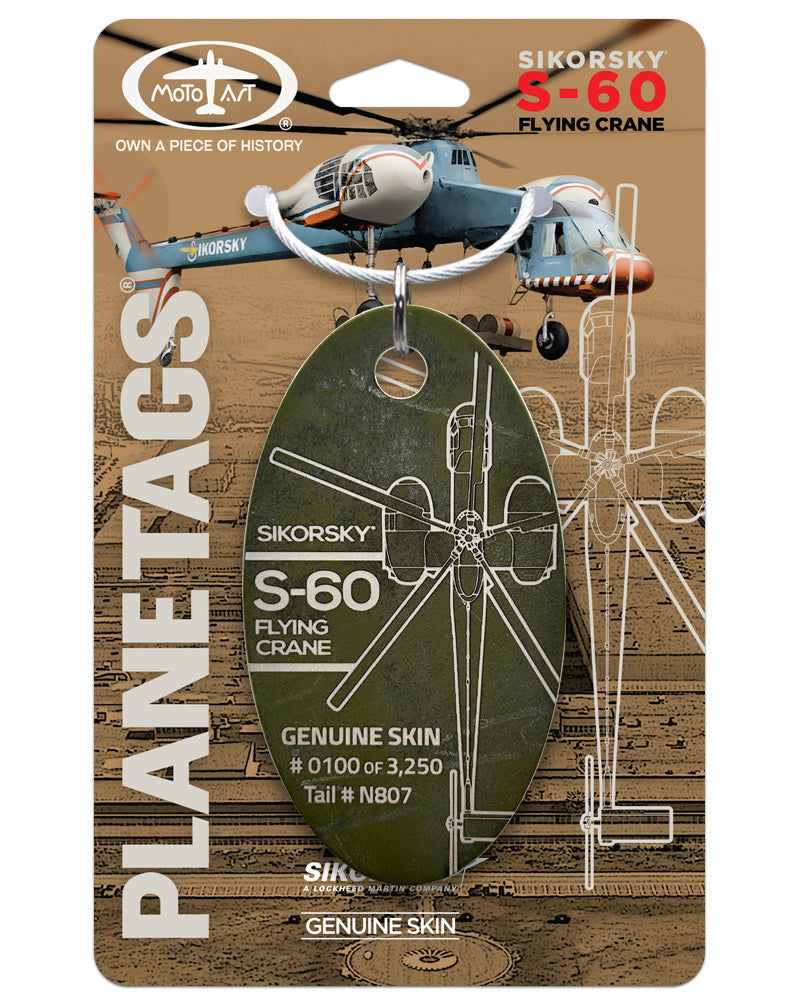


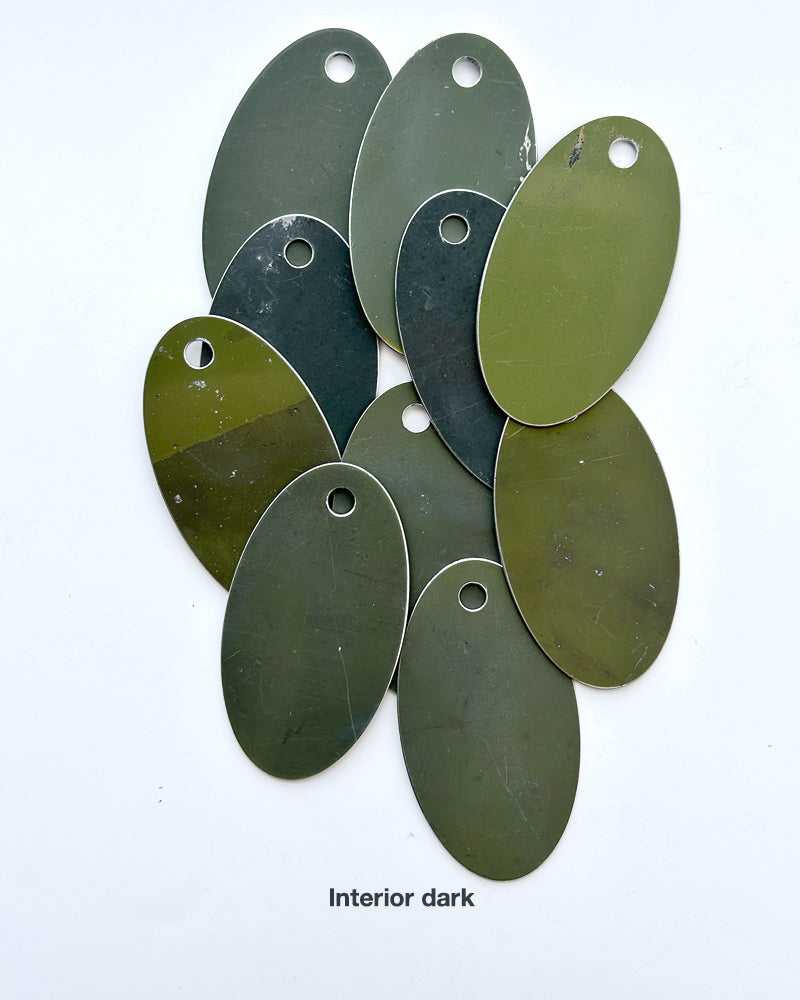
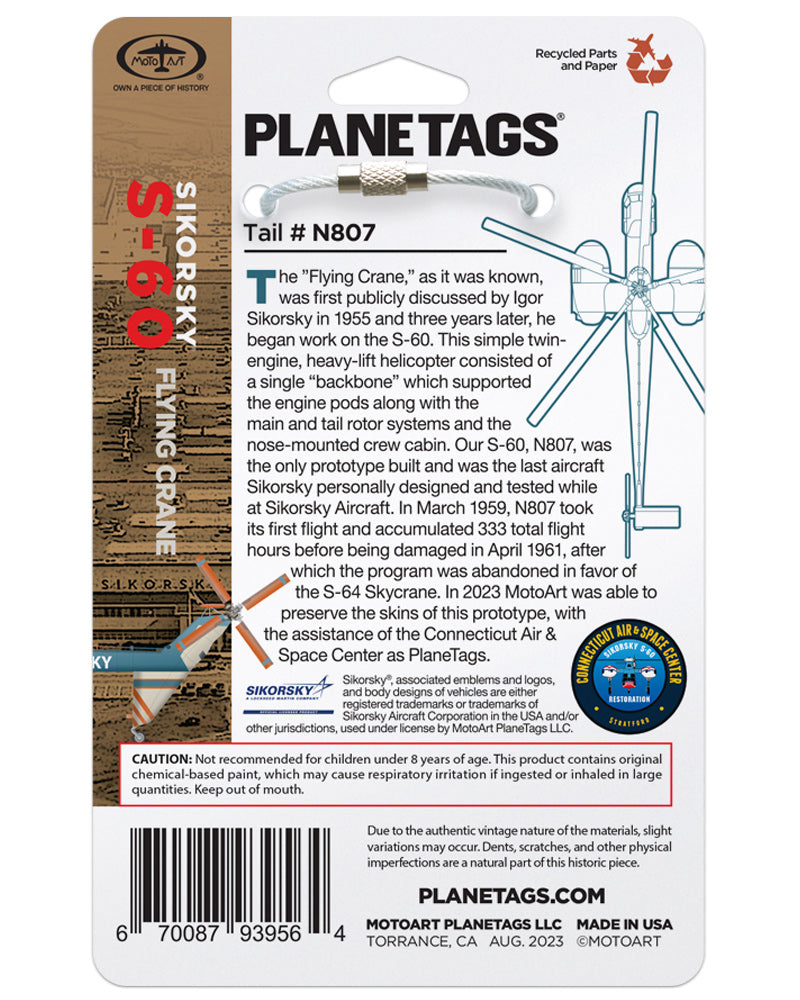
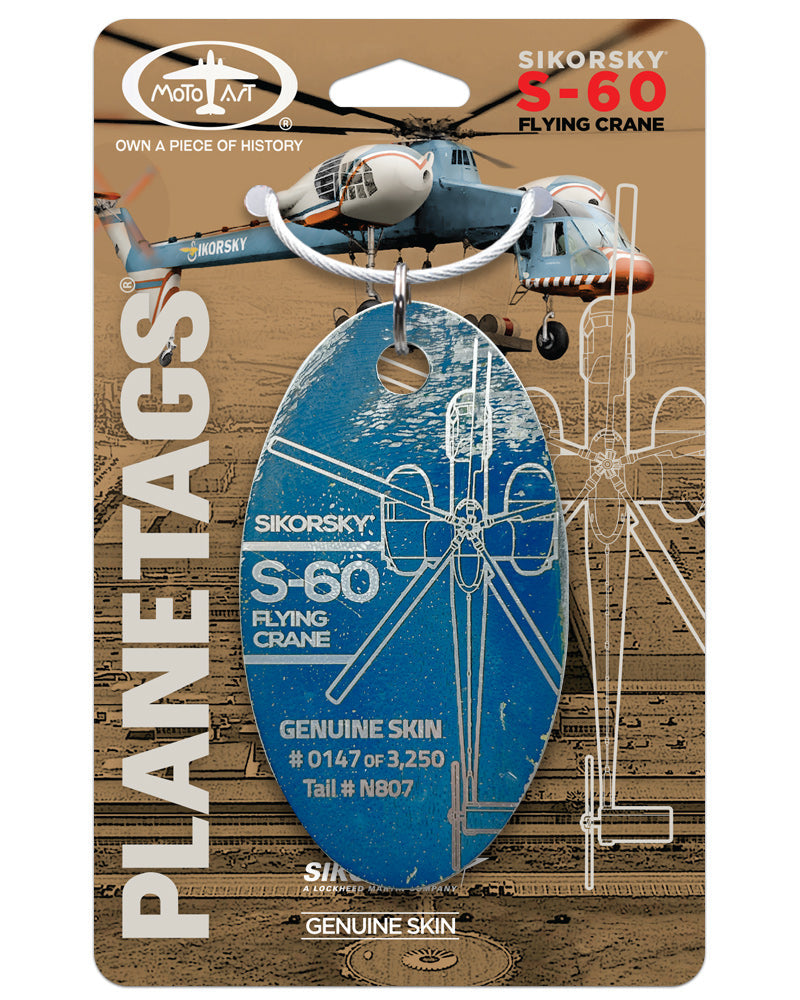
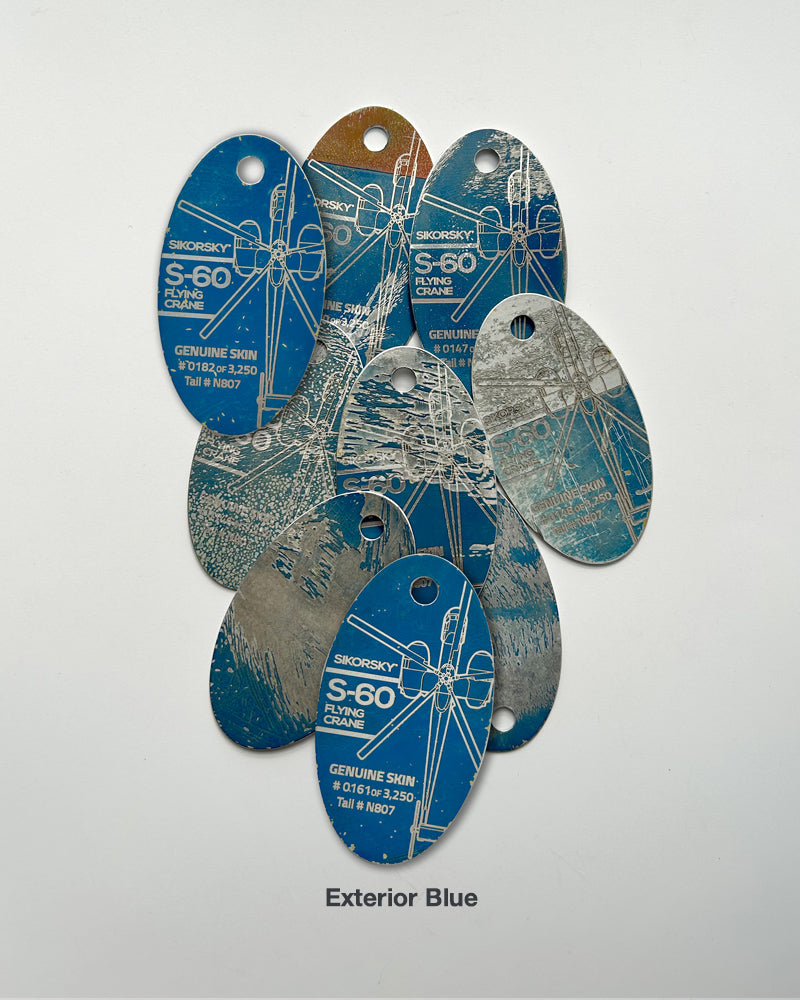
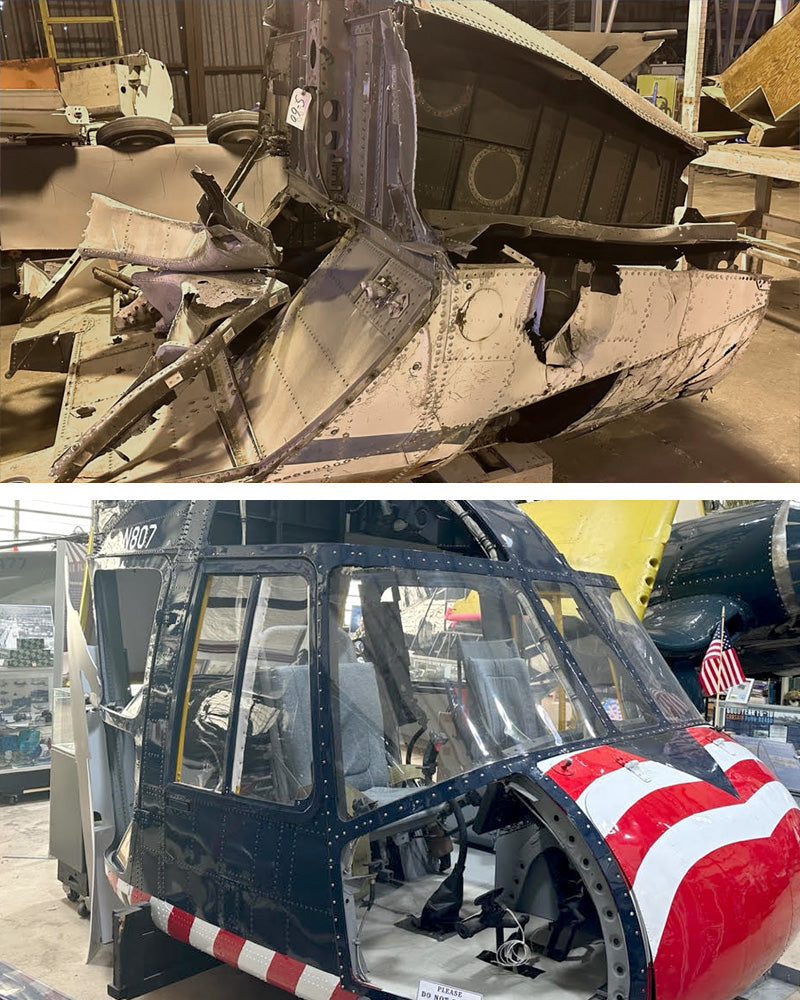
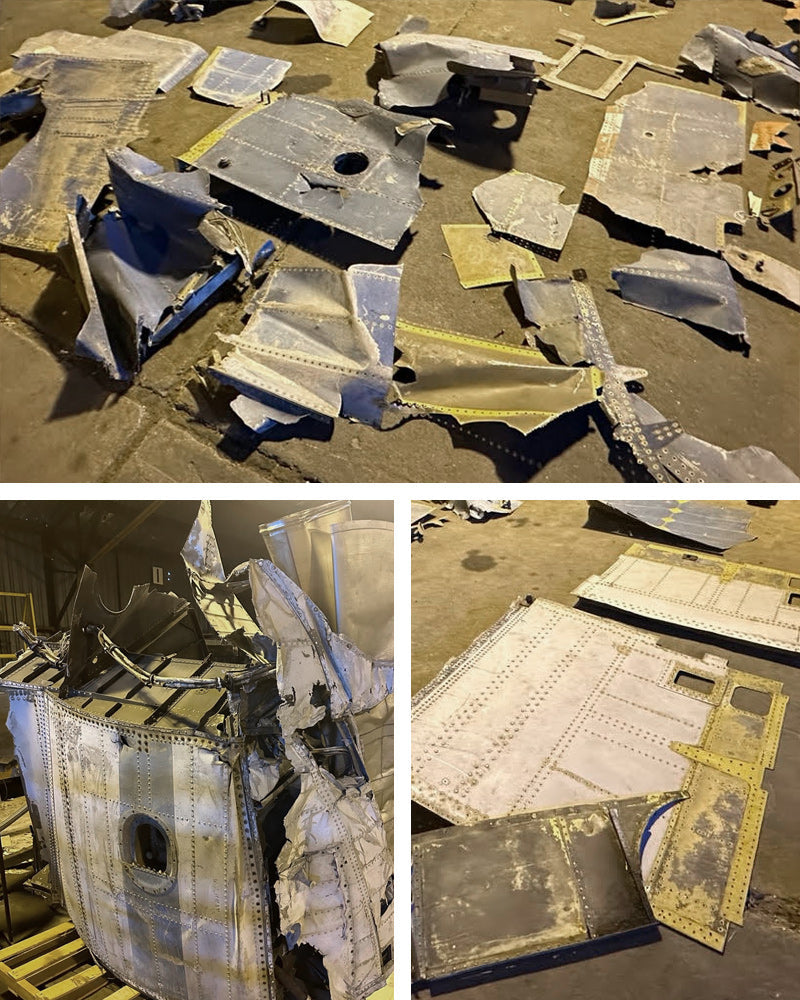
Custom S-60 Flying Crane N807
2
2 reviews 2 total reviews
Enter Your Engraving Info Below
Looking to engrave something unique? Check out our customization guide here.
Description
Description
Looking to engrave something unique? Check out our customization guide here.
PLEASE NOTE: PlaneTags will ship in random order as chosen from the variations shown in the photos. No requests accepted.

In 1958, Sikorsky Aircraft began designing a twin-engined, heavy-lift helicopter as a proof of concept for military and civilian uses. Although the prototype crashed in 1961, the S-60 led to the development of the successful S-64 Skycrane. Introducing Sikorsky S-60 Flying Crane PlaneTags, brought to you by MotoArt and the Connecticut Air and Space Center.
Get the full story on our blog- Sikorsky Helicopters: S-60 Flying Crane
OUR PLANE'S STORY
As far back as 1955, Igor Sikorsky spoke of his vision for a crane helicopter which would carry its cargo externally, attached to a simple fuselage which would also carry the mechanical systems and cockpit suspended below it. Advantages of the design were unobstructed visibility for the pilot, the ability to pick up payloads of all sizes and configurations while parked or hovering, and lower production and operational costs. The design would include dynamic components of the S-56/CH-37. N807, the sole S-60 prototype, took flight for the first time on March 25, 1959. It was used to demonstrate its ability in carrying, towing and hoisting various types of cargo, and mine sweeping.
Although effective, the S-60 was underpowered and eventually succeeded by an enlarged version with more powerful engines and a six blade rotor, the S-64. The S-60, instead, was to be delivered to NASA with an adjustment of the control sensitivity that would allow it to perform precision low speed maneuvers. Before it was delivered, during a check-out flight on April 3, 1961, it became unmanageable and crashed on the Sikorsky field. N807 was damaged beyond repair and remained stored outdoors for almost 50 years. Connecticut Air and Space Center obtained the airframe in 2010. In 2023, CASC provided the original skin from N807’s restoration to create S-60 PlaneTags.

The S-60 was Igor Sikorsky’s last aircraft design he was personally involved in and a notable part of aviation history. Make sure your collection includes Sikorsky S-60 PlaneTags. Get yours today!

S-60 Flying Crane-N807

Characteristics:
- Manufacturer: SIKORSKY
- Tail #: N807
- Crew: 3 (2 PILOTS, 1 CREW CHIEF)
- Rotor Diameter: 72 FT 0 IN w/5 BLADES
- Tail Rotor Diameter: 13 FT 0 IN w/4 BLADES
-
Length: 87 FT 11 IN
-
Height: 25 FT 8 IN
Performance:
- Range: 230 MI
- Cruise Speed: 115 MPH
- Ceiling: 8,000 FT
- Empty weight: 19,613 LB
-
Max Takeoff: 34,500 LB
- Rate of Climb: 2,900 FT / MINUTE
- Engine: 2x PRATT & WHITNEY R-2800-54 DOUBLE WASP
DISCLAIMER
Sikorsky®, associated emblems and logos, and body designs of vehicles are either registered trademarks or trademarks of Sikorsky Aircraft Corporation in the USA and/or other jurisdictions, used under license by MotoArt PlaneTags LLC.
Perfect Aviation Gift
PlaneTags are:
- Authentic - made from actual retired aircraft fuselage, not merely stamped metal.
- Unique - each PlaneTag bears the color, thickness, and wear and tear from the portion of the fuselage from which it was cut and it is therefore rare to create two identical PlaneTags.
- Collectible - each one is numbered in a limited edition and comes attached to a display card.
- Versatile - comes with a durable metal ring, strong enough to attach to luggage or keys or display.
*Important Notice – Please Read Carefully
PlaneTags are made from actual retired aircraft fuselage, not merely stamped metal. Because PlaneTags are made from real fuselage, each PlaneTag bears the color, thickness, and wear and tear from the portion of the fuselage from which it was cut and it is therefore rare to create two identical PlaneTags. These variations and imperfections are not product flaws. They are part of the beauty of PlaneTags. As a result, you will not have an option to select the color of your PlaneTag. The images on this website are provided for reference only and should not be used as the sole basis for choosing a particular PlaneTag.
Our Aircraft's Story
Our Aircraft's Story
Looking to engrave something unique? Check out our customization guide here.
PLEASE NOTE: PlaneTags will ship in random order as chosen from the variations shown in the photos. No requests accepted.

In 1958, Sikorsky Aircraft began designing a twin-engined, heavy-lift helicopter as a proof of concept for military and civilian uses. Although the prototype crashed in 1961, the S-60 led to the development of the successful S-64 Skycrane. Introducing Sikorsky S-60 Flying Crane PlaneTags, brought to you by MotoArt and the Connecticut Air and Space Center.
Get the full story on our blog- Sikorsky Helicopters: S-60 Flying Crane
OUR PLANE'S STORY
As far back as 1955, Igor Sikorsky spoke of his vision for a crane helicopter which would carry its cargo externally, attached to a simple fuselage which would also carry the mechanical systems and cockpit suspended below it. Advantages of the design were unobstructed visibility for the pilot, the ability to pick up payloads of all sizes and configurations while parked or hovering, and lower production and operational costs. The design would include dynamic components of the S-56/CH-37. N807, the sole S-60 prototype, took flight for the first time on March 25, 1959. It was used to demonstrate its ability in carrying, towing and hoisting various types of cargo, and mine sweeping.
Although effective, the S-60 was underpowered and eventually succeeded by an enlarged version with more powerful engines and a six blade rotor, the S-64. The S-60, instead, was to be delivered to NASA with an adjustment of the control sensitivity that would allow it to perform precision low speed maneuvers. Before it was delivered, during a check-out flight on April 3, 1961, it became unmanageable and crashed on the Sikorsky field. N807 was damaged beyond repair and remained stored outdoors for almost 50 years. Connecticut Air and Space Center obtained the airframe in 2010. In 2023, CASC provided the original skin from N807’s restoration to create S-60 PlaneTags.

The S-60 was Igor Sikorsky’s last aircraft design he was personally involved in and a notable part of aviation history. Make sure your collection includes Sikorsky S-60 PlaneTags. Get yours today!

S-60 Flying Crane-N807

Characteristics:
- Manufacturer: SIKORSKY
- Tail #: N807
- Crew: 3 (2 PILOTS, 1 CREW CHIEF)
- Rotor Diameter: 72 FT 0 IN w/5 BLADES
- Tail Rotor Diameter: 13 FT 0 IN w/4 BLADES
-
Length: 87 FT 11 IN
-
Height: 25 FT 8 IN
Performance:
- Range: 230 MI
- Cruise Speed: 115 MPH
- Ceiling: 8,000 FT
- Empty weight: 19,613 LB
-
Max Takeoff: 34,500 LB
- Rate of Climb: 2,900 FT / MINUTE
- Engine: 2x PRATT & WHITNEY R-2800-54 DOUBLE WASP
DISCLAIMER
Sikorsky®, associated emblems and logos, and body designs of vehicles are either registered trademarks or trademarks of Sikorsky Aircraft Corporation in the USA and/or other jurisdictions, used under license by MotoArt PlaneTags LLC.
Perfect Aviation Gift
PlaneTags are:
- Authentic - made from actual retired aircraft fuselage, not merely stamped metal.
- Unique - each PlaneTag bears the color, thickness, and wear and tear from the portion of the fuselage from which it was cut and it is therefore rare to create two identical PlaneTags.
- Collectible - each one is numbered in a limited edition and comes attached to a display card.
- Versatile - comes with a durable metal ring, strong enough to attach to luggage or keys or display.
*Important Notice – Please Read Carefully
PlaneTags are made from actual retired aircraft fuselage, not merely stamped metal. Because PlaneTags are made from real fuselage, each PlaneTag bears the color, thickness, and wear and tear from the portion of the fuselage from which it was cut and it is therefore rare to create two identical PlaneTags. These variations and imperfections are not product flaws. They are part of the beauty of PlaneTags. As a result, you will not have an option to select the color of your PlaneTag. The images on this website are provided for reference only and should not be used as the sole basis for choosing a particular PlaneTag.
Disclaimer
Disclaimer
Looking to engrave something unique? Check out our customization guide here.
PLEASE NOTE: PlaneTags will ship in random order as chosen from the variations shown in the photos. No requests accepted.

In 1958, Sikorsky Aircraft began designing a twin-engined, heavy-lift helicopter as a proof of concept for military and civilian uses. Although the prototype crashed in 1961, the S-60 led to the development of the successful S-64 Skycrane. Introducing Sikorsky S-60 Flying Crane PlaneTags, brought to you by MotoArt and the Connecticut Air and Space Center.
Get the full story on our blog- Sikorsky Helicopters: S-60 Flying Crane
OUR PLANE'S STORY
As far back as 1955, Igor Sikorsky spoke of his vision for a crane helicopter which would carry its cargo externally, attached to a simple fuselage which would also carry the mechanical systems and cockpit suspended below it. Advantages of the design were unobstructed visibility for the pilot, the ability to pick up payloads of all sizes and configurations while parked or hovering, and lower production and operational costs. The design would include dynamic components of the S-56/CH-37. N807, the sole S-60 prototype, took flight for the first time on March 25, 1959. It was used to demonstrate its ability in carrying, towing and hoisting various types of cargo, and mine sweeping.
Although effective, the S-60 was underpowered and eventually succeeded by an enlarged version with more powerful engines and a six blade rotor, the S-64. The S-60, instead, was to be delivered to NASA with an adjustment of the control sensitivity that would allow it to perform precision low speed maneuvers. Before it was delivered, during a check-out flight on April 3, 1961, it became unmanageable and crashed on the Sikorsky field. N807 was damaged beyond repair and remained stored outdoors for almost 50 years. Connecticut Air and Space Center obtained the airframe in 2010. In 2023, CASC provided the original skin from N807’s restoration to create S-60 PlaneTags.

The S-60 was Igor Sikorsky’s last aircraft design he was personally involved in and a notable part of aviation history. Make sure your collection includes Sikorsky S-60 PlaneTags. Get yours today!

S-60 Flying Crane-N807

Characteristics:
- Manufacturer: SIKORSKY
- Tail #: N807
- Crew: 3 (2 PILOTS, 1 CREW CHIEF)
- Rotor Diameter: 72 FT 0 IN w/5 BLADES
- Tail Rotor Diameter: 13 FT 0 IN w/4 BLADES
-
Length: 87 FT 11 IN
-
Height: 25 FT 8 IN
Performance:
- Range: 230 MI
- Cruise Speed: 115 MPH
- Ceiling: 8,000 FT
- Empty weight: 19,613 LB
-
Max Takeoff: 34,500 LB
- Rate of Climb: 2,900 FT / MINUTE
- Engine: 2x PRATT & WHITNEY R-2800-54 DOUBLE WASP
DISCLAIMER
Sikorsky®, associated emblems and logos, and body designs of vehicles are either registered trademarks or trademarks of Sikorsky Aircraft Corporation in the USA and/or other jurisdictions, used under license by MotoArt PlaneTags LLC.
Perfect Aviation Gift
PlaneTags are:
- Authentic - made from actual retired aircraft fuselage, not merely stamped metal.
- Unique - each PlaneTag bears the color, thickness, and wear and tear from the portion of the fuselage from which it was cut and it is therefore rare to create two identical PlaneTags.
- Collectible - each one is numbered in a limited edition and comes attached to a display card.
- Versatile - comes with a durable metal ring, strong enough to attach to luggage or keys or display.
*Important Notice – Please Read Carefully
PlaneTags are made from actual retired aircraft fuselage, not merely stamped metal. Because PlaneTags are made from real fuselage, each PlaneTag bears the color, thickness, and wear and tear from the portion of the fuselage from which it was cut and it is therefore rare to create two identical PlaneTags. These variations and imperfections are not product flaws. They are part of the beauty of PlaneTags. As a result, you will not have an option to select the color of your PlaneTag. The images on this website are provided for reference only and should not be used as the sole basis for choosing a particular PlaneTag.
Caution: Not recommended for children under 8 years of age. This product contains chemical-based paint which may cause respiratory irritation if ingested or inhaled in large quantities. Keep out of mouth.

Custom S-60 Flying Crane N807

